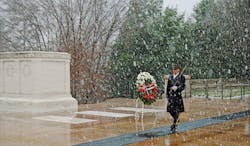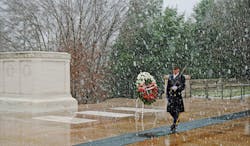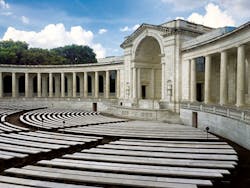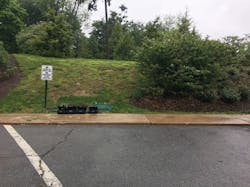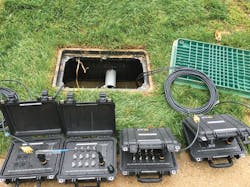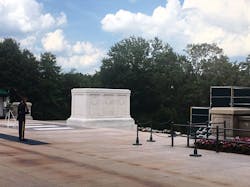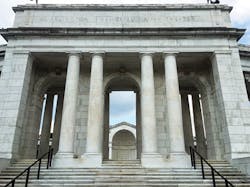By Jerry L. Bowman, RCDD, RTPM, CISSP, CPP, CDCDP; IMTAS
Nestled within the tranquil 1,100 acres of Arlington National Cemetery is the exquisitely marbled Memorial Amphitheater, built in 1920, and where more than 3,000 ceremonies per year-including Memorial Day-are conducted to honor the military men and women who served to keep the United States free. In the Amphitheater’s plaza, atop a hill overlooking Washington, D.C. is the 79-ton Tomb of the Unknowns that pays tribute to unknown soldiers from World War I through the Vietnam War. The tomb is guarded 24 hours a day, 365 days a year by volunteers of the elite 3rd U.S. Infantry Regiment, traditionally known as The Old Guard. In full dress uniform and carrying M-14 rifles, these Tomb Guard sentinels are expected to march on, whether in sleet, snow, rain or storm.
The Amphitheater and Tomb of the Unknowns served as the backdrop for the preparation of the major network broadcasting (e.g. ABC, CNN, CBS and all news media) of President Barack Obama’s Memorial Day speech on Monday, May 30, 2016. As one can imagine, nothing less than the execution of flawless audio and high-bandwidth HD video transmission and maximum reliability were required for such an important event; even a small disruption in the signal transport would have been disastrous.
Like the Tomb Guard sentinels, Arlington National Cemetery, under the jurisdiction of the Department of the Army, demands the utmost commitment and dedication of its civilian workforce, whether it is its team of horticulturalists, caregivers, or technology professionals who are expected to perform par excellence regardless of weather conditions or any unforeseen obstacles. The mission must be accomplished with no excuses allowed-such are the unique challenges confronting the broadcast technology team contracted to execute the Memorial Day event.
As the prime contractor, General Dynamics, selected Global Com Inc. (www.globalcomva.com), an Arlington, VA-based company, to design and install the connectivity infrastructure for the Amphitheater media project, including procurement, integration, installation, and testing.
Global Com has a long history of successfully executing government projects, and their engineering staff’s understanding of the unique requirements for this project. Their speed, agility, flexible working hours, and “no-excuse” approach to project budget and deadlines demanded precision planning and execution.
Innovative problem solving with effective preplanning
With more than 4 million visitors per year, Arlington National Cemetery prides itself on creating a serene and peaceful environment through its undisturbed landmarks and impeccable landscaping that includes 576 acres of turf grass and more than 8,500 trees of 300 different species. Requiring no visible disruption to its grounds for visitors, the installation of conduit and optical fiber for the aggressive three-week project was often scheduled during night hours. Moreover, Global Com’s senior project manager, Brian Schmidt, RCDD, had to manage and schedule a team of landscapers that had to replant flowers, shrubs or grass immediately after installation. By early morning, the areas of installation on the grounds of the Amphitheater and the Tomb of the Unknowns had to look exactly as it had the day before, with no detection that the grounds had at all been touched.
This type of unusual requirement is typical when working on high-profile government facilities and national landmarks. It serves as just one example of the comprehensive preplanning element of Global Com’s zero-defect project management approach. The preplanning team sessions began weeks in advance of the actual project’s start, requiring detailed analysis of all variables and the applications of innovative problem solving-all mission-critical when working any high-profile government project.
The connectivity end points for the Amphitheater media project began at the front parking lot of the Amphitheater where the broadcasters’ outside broadcast trucks gather to send ultimately real-time audio and high-bandwidth 4k HD video feeds to their respective studios and network destinations for live global broadcasting televised for millions of anxious viewers. The termination end point from which broadcasters receive their broadcast signals was located at the media setup adjacent to the 25-foot wall where the sentinels march at the Tomb of the Unknowns. Moreover, Global Com also faced a transition from underground to aerial for a camera set-up on top of the Amphitheater’s roof for aerial broadcast shots of the Memorial Day event.
Each broadcast remote unit has its own unique requirements that Global Com had to accommodate with an infrastructure pathway that ensured successful event broadcasting. In similar remote broadcasting locations, this is accomplished by installing strategically placed handholes for the optical fiber cable access. According to ANSI/TIA-758-A-2004 “Customer-owned Outside Plant Telecommunications Infrastructure Standard,” an industry best practice for outside plant cable access is the use of handholes. The problem? A permanent outside plant fixture, such as a handhole, was not permitted at the media setup at the Tomb of the Unknowns due to aesthetic disruption to the landmark. These kinds of challenges require skills that exceed simple knowledge of standards. They require innovative, solution-based design.
PM Schmidt and his Global Com team initially proposed innovative solutions ranging from hiding various enclosures within fabricated stone to other creative stealth enclosures. Proposals had been rejected until custom-designed and -made mobile, portable breakout boxes received a resounding “Yes” from Arlington National Cemetery decision-makers. The six custom 18x12x9-inch mobile breakout boxes provide connectivity to the broadcasters’ active equipment. Four of these unique boxes were located at the parking lot, serving the rooftop cameras and the Tomb of the Unknowns; the other two were placed inside an underground NEMA-rated enclosure hidden within a planter at the Tomb site. The boxes are not permanent fixtures and can be stored away when not in use.
Global Com used singlemode MPO-interface connections that plug directly into the fiber trunk cables at the front parking lot where the outside broadcast vans are situated. The breakout boxes used various connections including rugged, tactical Duo OpticalCon connectors with singlemode MPO connectivity. This met the specific needs of CNN, while a singlemode MPO connector terminated with ST connectors were used for ABC’s specific broadcasting requirements, and so on.
Schmidt explained that, “Fast and innovative problem-solving is essential when working with a high-profile client like Arlington National Cemetery.”
The team from Global Com delivered an ingenious solution with the customized portable breakout boxes and unobtrusive infrastructure design that made Memorial Day 2016 broadcasting a success. Additionally, their creative solutions will serve Arlington National Cemetery’s broadcasting requirements for years to come.
Installation highlights
To ensure optimum reliability for the Amphitheater media project’s network infrastructure, Global Com identified the most rugged and dependable optical fiber cable and connectivity products-such as the 12-count singlemode OSP tight-buffered cable with ruggedized MPO connectors. The tight-buffered feature allows smaller packaging and space savings for enhanced flexibility, important for the utilization of smaller breakout boxes.
The NEMA-rated waterproof enclosures were also chosen for ruggedness and strong performance attributes to withstand the harshest environmental conditions given Washington, D.C.’s often-unpredictable weather conditions. Singlemode fiber was used throughout the infrastructure because of its exceptional transmission properties and resistance to electromagnetic interference that could compromise broadcast signal integrity.
Meeting the many justifiable restrictions and aesthetic landmark constraints posed by Arlington National Cemetery, Global Com had to be ready to design a non-typical infrastructure and to deploy often non-typical installation methods. From the parking lot, new conduit and fiber-optic trunk cables were installed using directional boring 300 feet from the location of the Tomb of the Unknowns. Directional boring (horizontal directional drilling) is a trenchless method of installing piping and cable systems underground along a predetermined path by the use of highly specialized drilling equipment.
One key benefit to directional boring is the almost total lack of impact on landscapes, roadways and vehicle traffic. Due to the 25-foot wall, a new 18-foot pole was installed unobtrusively within the trees and woodland. To preserve the century-old trees, Arlington National Cemetery levies a $225,000 fine if a tree is killed by anyone-whether a team of horticulturalists, archeologists, or IT infrastructure installers. The trunk cables were installed through a manhole, up the pole, over the wall, and into the planter that discreetly housed the NEMA box.
The fiber-optic trunk cables passed through primary existing conduit to the Amphitheater entrance where a new installation of plenum-rated 12-count singlemode fiber was transitioned through the basement that houses century-old catacombs, around the building, up existing riser conduits, and finally terminated at the NEMA box on the Amphitheater rooftop. Even there, atypical installation methods were employed, since no drilling could be done on the building’s massive marble columns to complete the aerial camera broadcasting setup.
The Amphitheater media project was completed on time and on budget with the exceptional speed, operational efficiency, and innovative problem-solving expected by Arlington National Cemetery management.
From the infrastructure design, effective preplanning, ready-for-anything mentality, and the dedication and commitment of the installation team characterized by post-midnight work details and 24x7 service, the media project exceeded the Department of the Army’s highest expectations.
Those high expectations are necessary to execute any military supervised project flawlessly and, in this case, to pay tribute by globally broadcasting our nation’s gratitude to our honored service men and women who sacrificed their lives for every U.S. citizen.
Jerry L. Bowman, RCDD, RTPM, CISSP, CPP, CDCDP is chief business development officer for IMTAS (imtas.com), a 24-year technology services and support company to federal and state government. He currently serves as president and chief executive officer of InfraGard and is a BICSI past president, having served in that capacity from 2012-2014. Bowman can be reached at [email protected].
